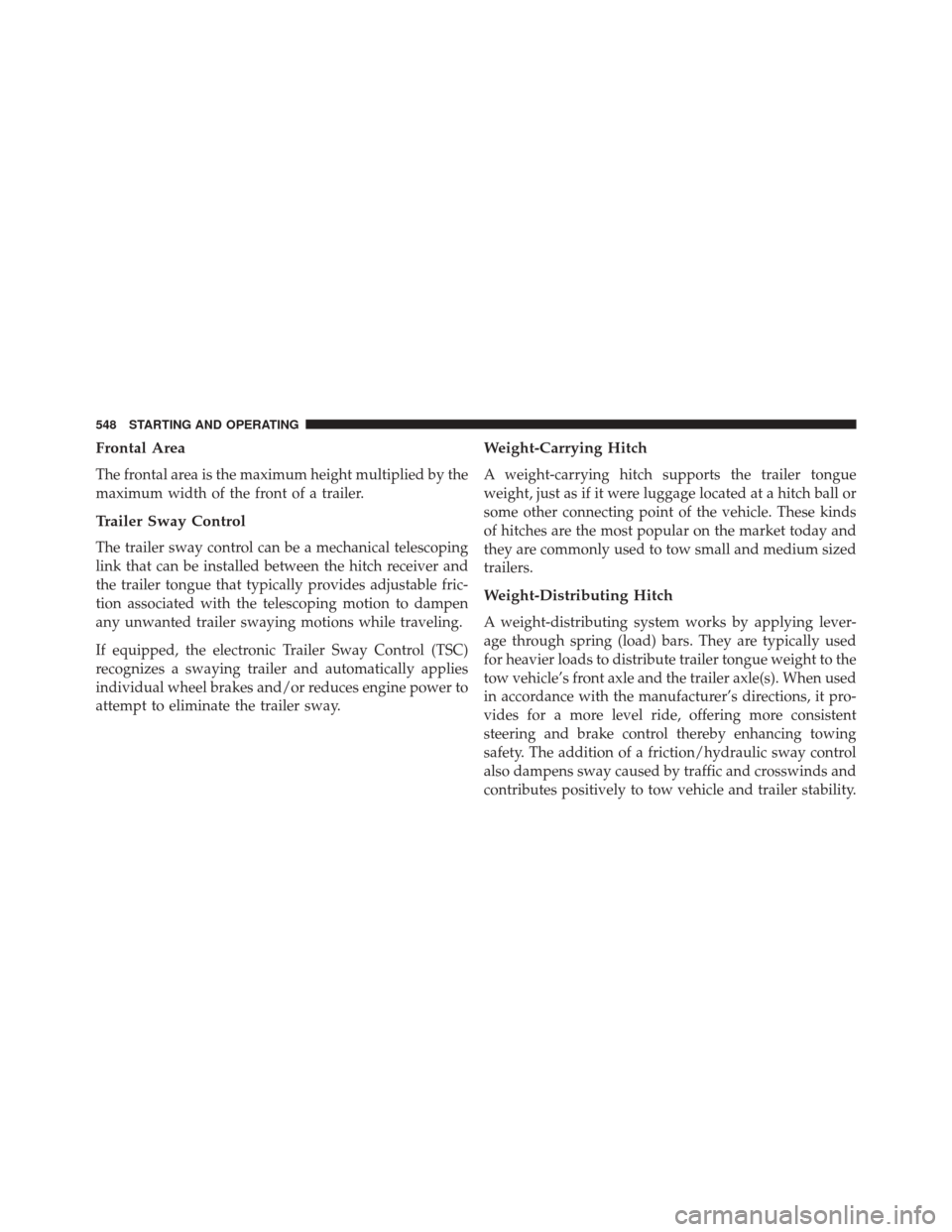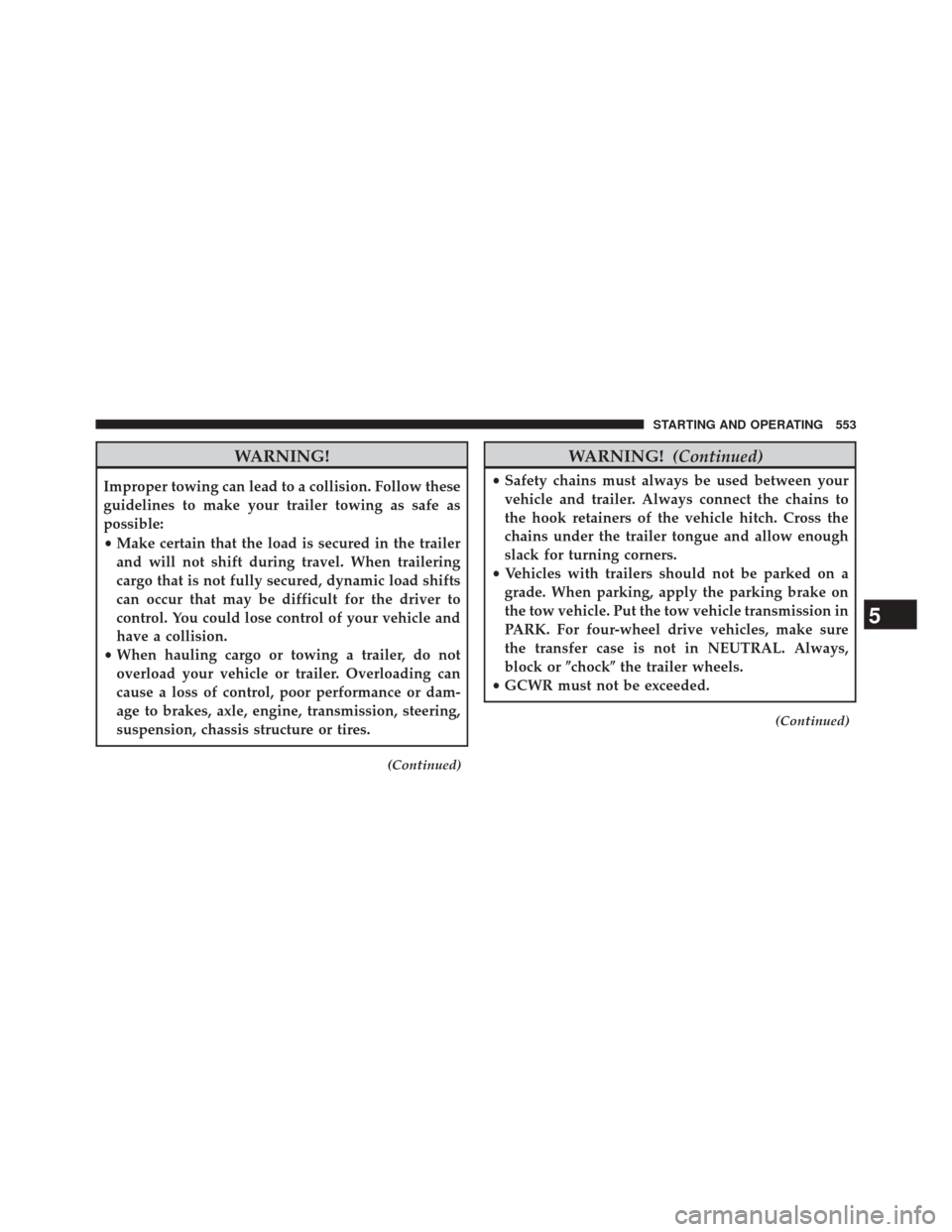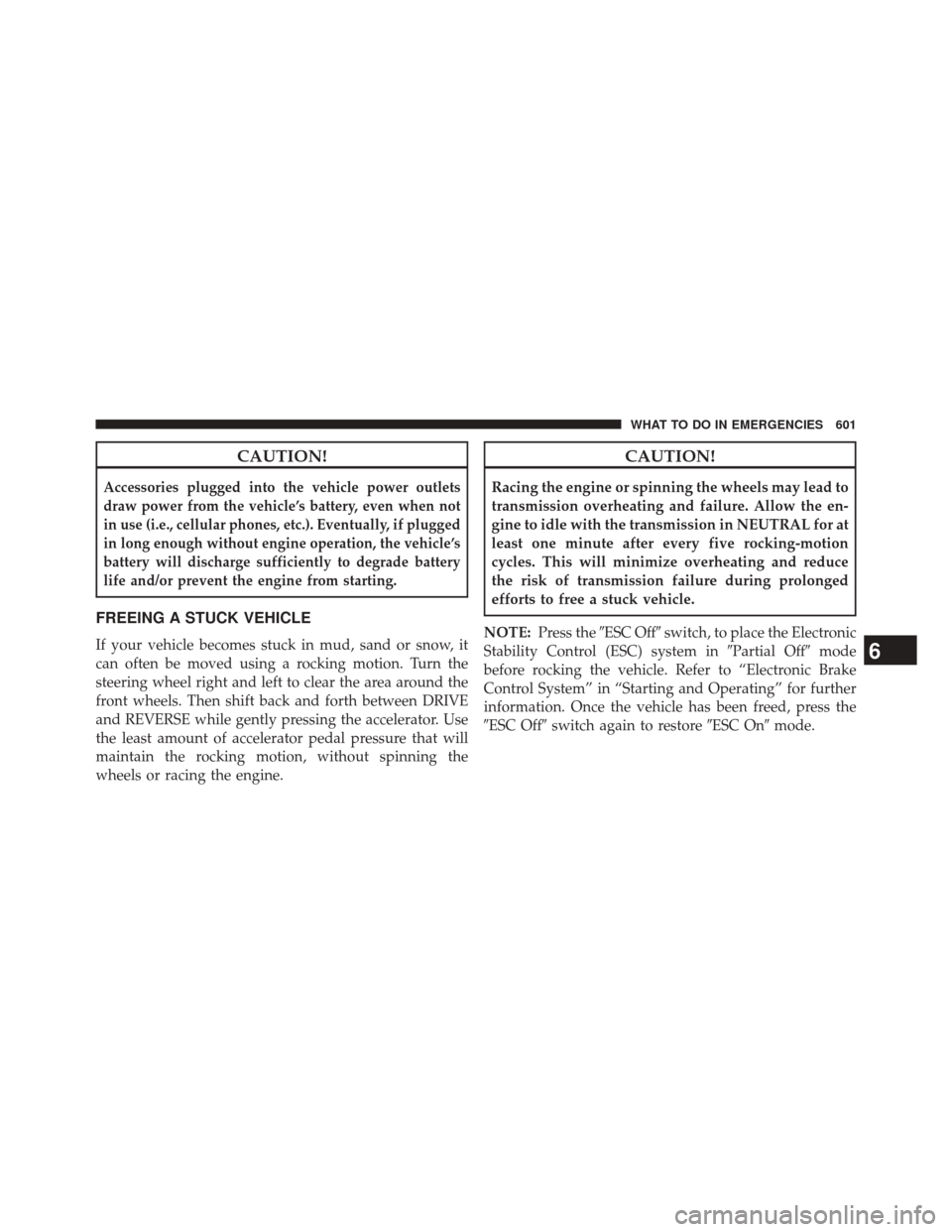Page 550 of 703

Frontal Area
The frontal area is the maximum height multiplied by the
maximum width of the front of a trailer.
Trailer Sway Control
The trailer sway control can be a mechanical telescoping
link that can be installed between the hitch receiver and
the trailer tongue that typically provides adjustable fric-
tion associated with the telescoping motion to dampen
any unwanted trailer swaying motions while traveling.
If equipped, the electronic Trailer Sway Control (TSC)
recognizes a swaying trailer and automatically applies
individual wheel brakes and/or reduces engine power to
attempt to eliminate the trailer sway.
Weight-Carrying Hitch
A weight-carrying hitch supports the trailer tongue
weight, just as if it were luggage located at a hitch ball or
some other connecting point of the vehicle. These kinds
of hitches are the most popular on the market today and
they are commonly used to tow small and medium sized
trailers.
Weight-Distributing Hitch
A weight-distributing system works by applying lever-
age through spring (load) bars. They are typically used
for heavier loads to distribute trailer tongue weight to the
tow vehicle’s front axle and the trailer axle(s). When used
in accordance with the manufacturer’s directions, it pro-
vides for a more level ride, offering more consistent
steering and brake control thereby enhancing towing
safety. The addition of a friction/hydraulic sway control
also dampens sway caused by traffic and crosswinds and
contributes positively to tow vehicle and trailer stability.
548 STARTING AND OPERATING
Page 555 of 703

WARNING!
Improper towing can lead to a collision. Follow these
guidelines to make your trailer towing as safe as
possible:
•Make certain that the load is secured in the trailer
and will not shift during travel. When trailering
cargo that is not fully secured, dynamic load shifts
can occur that may be difficult for the driver to
control. You could lose control of your vehicle and
have a collision.
• When hauling cargo or towing a trailer, do not
overload your vehicle or trailer. Overloading can
cause a loss of control, poor performance or dam-
age to brakes, axle, engine, transmission, steering,
suspension, chassis structure or tires.
(Continued)
WARNING! (Continued)
•Safety chains must always be used between your
vehicle and trailer. Always connect the chains to
the hook retainers of the vehicle hitch. Cross the
chains under the trailer tongue and allow enough
slack for turning corners.
• Vehicles with trailers should not be parked on a
grade. When parking, apply the parking brake on
the tow vehicle. Put the tow vehicle transmission in
PARK. For four-wheel drive vehicles, make sure
the transfer case is not in NEUTRAL. Always,
block or �chock�the trailer wheels.
• GCWR must not be exceeded.
(Continued)
5
STARTING AND OPERATING 553
Page 603 of 703

CAUTION!
Accessories plugged into the vehicle power outlets
draw power from the vehicle’s battery, even when not
in use (i.e., cellular phones, etc.). Eventually, if plugged
in long enough without engine operation, the vehicle’s
battery will discharge sufficiently to degrade battery
life and/or prevent the engine from starting.
FREEING A STUCK VEHICLE
If your vehicle becomes stuck in mud, sand or snow, it
can often be moved using a rocking motion. Turn the
steering wheel right and left to clear the area around the
front wheels. Then shift back and forth between DRIVE
and REVERSE while gently pressing the accelerator. Use
the least amount of accelerator pedal pressure that will
maintain the rocking motion, without spinning the
wheels or racing the engine.
CAUTION!
Racing the engine or spinning the wheels may lead to
transmission overheating and failure. Allow the en-
gine to idle with the transmission in NEUTRAL for at
least one minute after every five rocking-motion
cycles. This will minimize overheating and reduce
the risk of transmission failure during prolonged
efforts to free a stuck vehicle.
NOTE: Press the �ESC Off� switch, to place the Electronic
Stability Control (ESC) system in �Partial Off�mode
before rocking the vehicle. Refer to “Electronic Brake
Control System” in “Starting and Operating” for further
information. Once the vehicle has been freed, press the
�ESC Off� switch again to restore �ESC On�mode.
6
WHAT TO DO IN EMERGENCIES 601
Page 651 of 703
Cavity Cartridge Fuse Mini-FuseDescription
M15 —20 Amp Yellow Rear View Mirror, Instrument Cluster, Multi-
Function Control Switch, Tire Pressure Monitor,Glow Plug Module – If Equipped
M16 —10 Amp Red Airbag Module/Occupant Classification Module
M17 —15 Amp Blue Left Tail/License/Park Lamp, Running Lamps
M18 —15 Amp Blue Right Tail/Park/Run Lamp
M19 —25 Amp Natural Powertrain
M20 —15 Amp Blue Instrument Cluster Interior Light, Switch Bank,
Steering Column Module, Switch Steering Wheel
M21 —20 Amp Yellow Powertrain
M22 —10 Amp Red Horn
M23 —10 Amp Red Horn
M24 —25 Amp Natural Rear Wiper
M25 —20 Amp Yellow Fuel Pump, Diesel Lift Pump – If Equipped
M26 —10 Amp Red Power Mirror Switch, Driver Window Switch
7
MAINTAINING YOUR VEHICLE 649
Page 697 of 703

Shoulder Belts............................66
Side Airbag ..............................91
Signals, Turn ........................... .127
Sliding Door .............................50
SmartBeams ............................ .233
Snow Chains (Tire Chains) ...................522
Snow Tires ............................. .514
Spare Tire .............................. .516
Speed Control (Cruise Control) ................243
Speedometer ............................ .326
Starting ............................... .461
Automatic Transmission ..................461
Cold Weather ......................... .465
Engine Fails to Start .....................465
Remote ...............................32
Starting and Operating .....................461
Starting Procedures ....................... .461
Steering Power .............................. .484Tilt Column
.......................... .239
Wheel, Heated ........................ .240
Wheel, Tilt ........................... .239
Steering Wheel Audio Controls ...............435
Steering Wheel Mounted Sound System Controls . . .435
Storage ............................... .651
Storage Bin ............................. .285
Storage, Vehicle .......................... .651
Storing Your Vehicle ...................... .651
Stow n Go (Fold in Floor) Seats ...............201
Sunglasses Storage ....................... .260
Sun Roof .............................. .272
Supplemental Restraint System - Airbag ..........81
Sway Control, Trailer ...................... .496
Synthetic Engine Oil ...................... .617
System, Remote Starting .....................32
Tachometer ............................. .319
Telescoping Steering Column .................239
10
INDEX 695